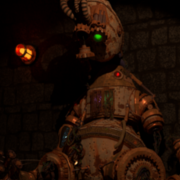I would suggest you first get a working process running. Then, if needed, profile the process to determine where improvements could be made.
i've got all the code up and running.
its just a test routine off the tools menu in Caveman 3.0, but it does the following:
loads and draws skinned meshes with multiple animations, and can change between animations. no animation blending yet.
supports all 5 or 6 skinning methods from tiny.cpp.
can set the texture for each mesh in a skinned mesh on the fly before drawing. textures can be pooled. materials can be pooled if desired.
can draw an object in relation to a bone (IE attach wpn to hand bone type stuff).
drawing multiple instances of a skinned mesh, each with its own animation controller, using a single shared skinned mesh and skeleton.
there's different versions of the code so you can load non-pooled textures and materials with the mesh and use them for drawing subsets, like a regular dx mesh,
or you can draw using the current texture and material for all meshes and subsets in the skinned mesh, or you can set textures for each mesh in the skinned mesh individually, then draw it using the current material.
the last thing i tested was using the in-game realtime 10 channel matrix editor to scale, rotate, and translate eyeballs to their correct position with respect to the head bone, while playing an animation where they don't move. this allows me to read off the srt values for use in a pre-defined "offset" matrix used to draw each eye. since the eyes are drawn as an attachment to a bone, i can change their texture, or make them look in any direction desired. to support visual tracking, the xr and yr angles from the lookat (or camera's forward) vector to the target's direction vector from the camera should be the rotations that need to be applied before the offset matrix, follwed then by the combinedtransform matrix - i think. haven't tested it yet, but i think its right, might need to negate the angles or something.
about the only code left is a skinned mesh pool class, and a controller pool class. i've pseudo coded them, but was too lazy at 1am last night to lookup syntax and var names, so it still needs about and hour's worth of work perhaps, at most.
so i'm more or less ready to go for it with a fully rigged and ready to rock model. the question is how many tris? i started with a beautiful mesh - excellent topology, easy to mod, looked great right out of the box. when i went to export with two animations, i thought blender had crashed. i tried exporting just the mesh. it took 10 minutes. turned out the mesh was over 100K tris. i decimated it to about 10K for testing, but the topology was ruined. about half way through testing, i switched to a nice topology mesh of about 30K tris. but this is probably still a bit big for 100 onscreen at once type of thing. a female will require 3 drawsubset calls - a male, two calls (no bra). i decided to implement bra and loincloth as separate meshes along with a head and body mesh, as the two or three meshes in a single skinned mesh. eyeballs and hair will add three more DIP calls per character, using static VBs and IBs. in my rigid body system, i'm using 14 (male) or 15 (female) static meshes to draw a character (if they're bald, subtract one hair mesh). some of them i know are perhaps unreasonably highpoly, 50K for a body, 20K for a head, that kind of thing. but they're all static. i was somewhat surprised to find little difference in FPS between various skinning methods in tiny.cpp sample running on my pc. something like 169 vs 175.





